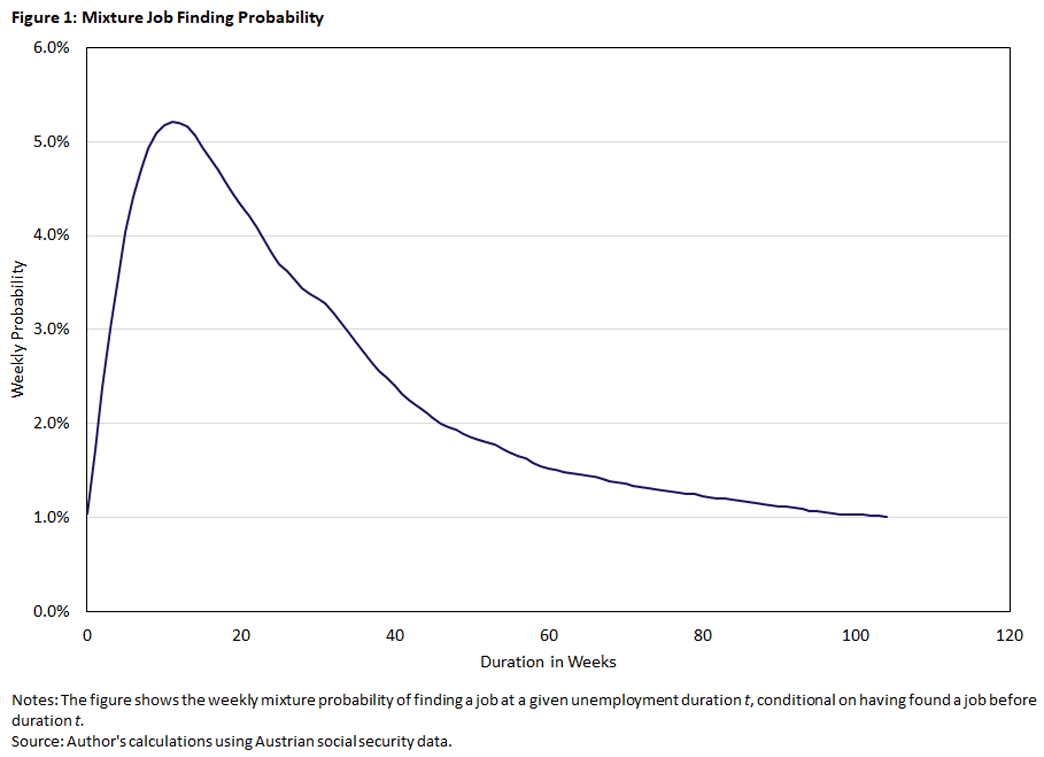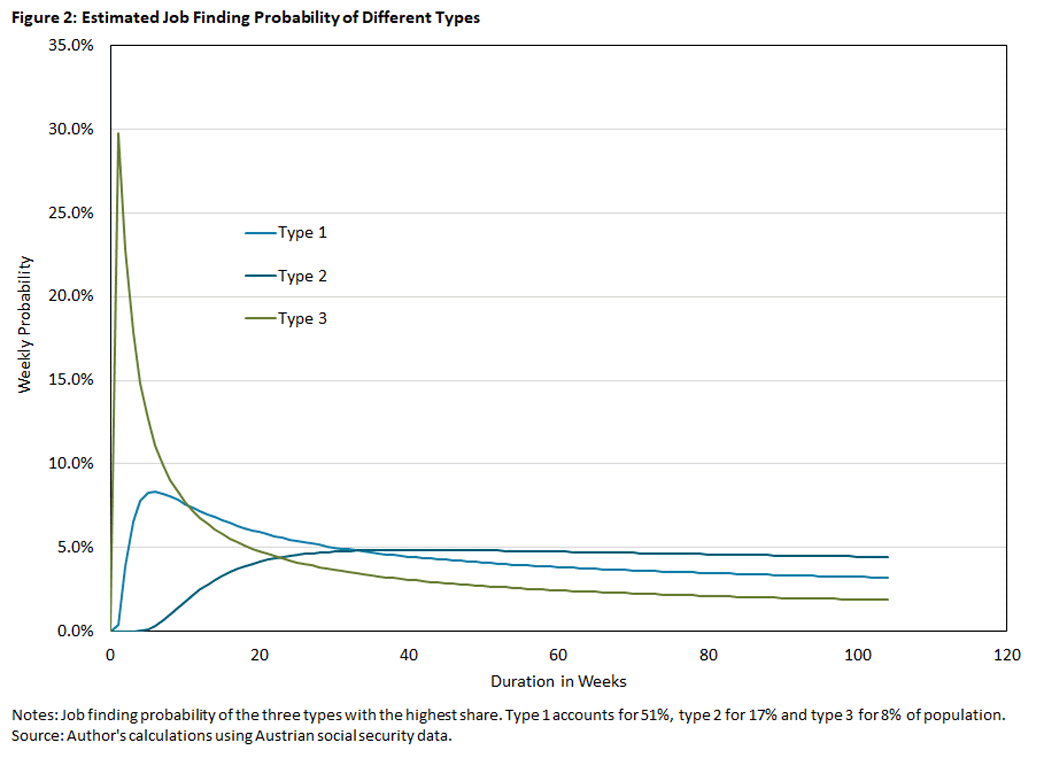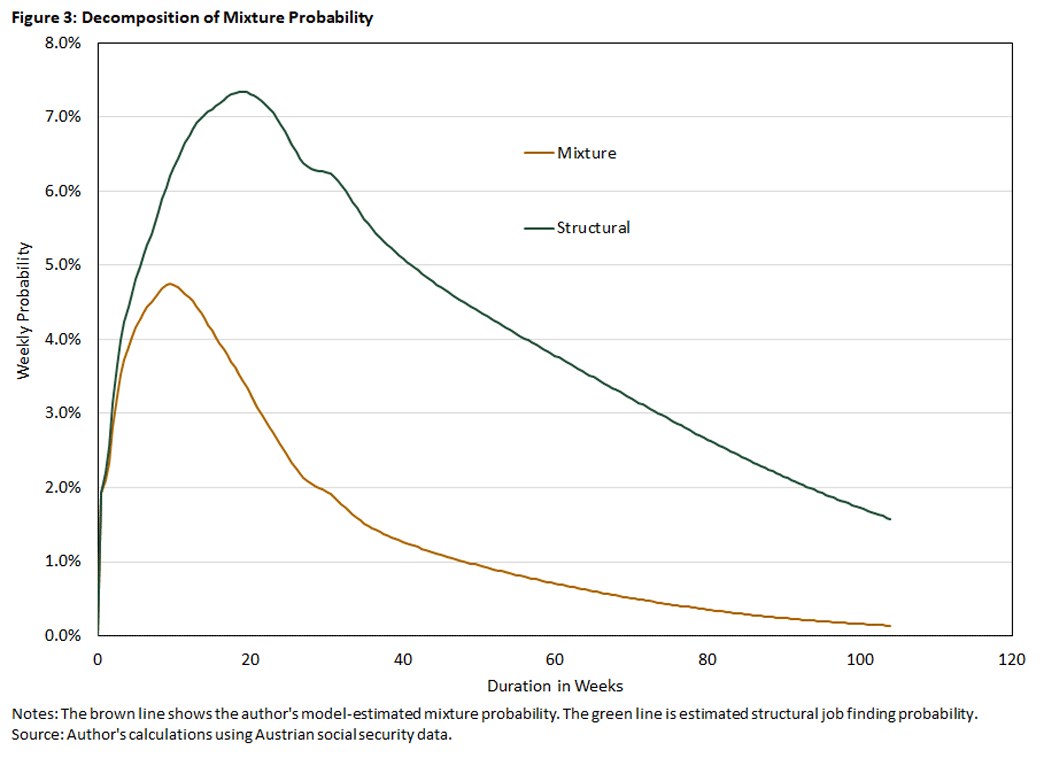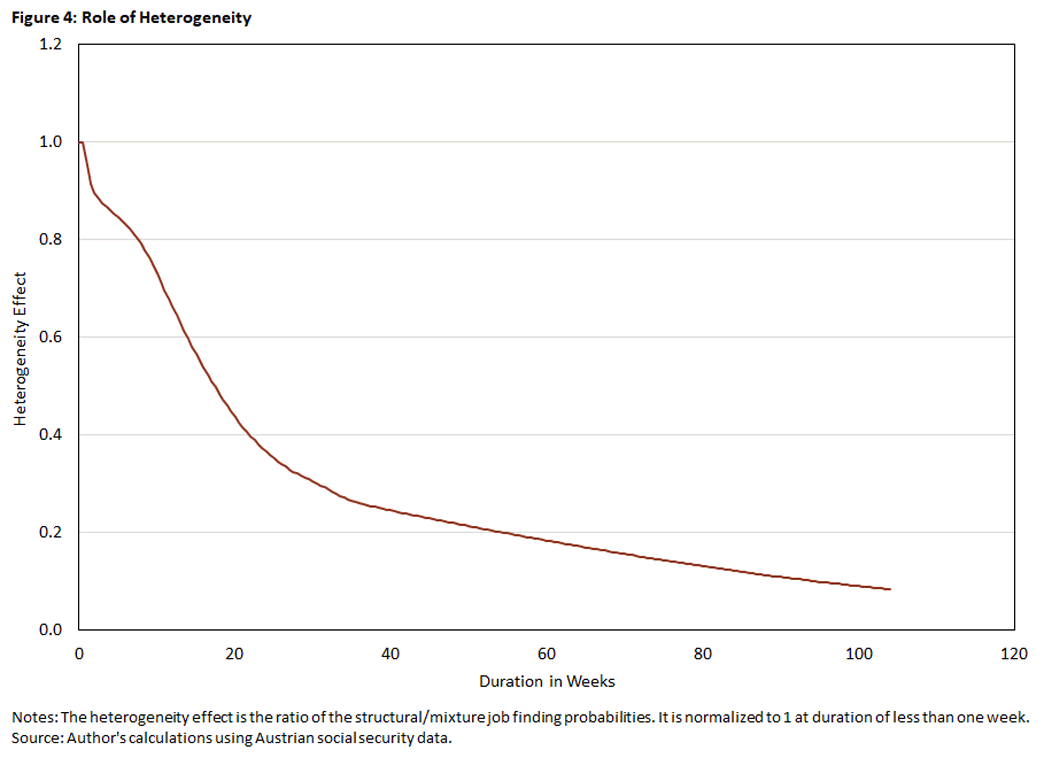Why Do Long-Term Unemployed Workers Struggle to Find New Jobs?
The job finding probabilities of workers who just lost their jobs are higher than for those who have been unemployed for several months. There are two broad reasons why this is the case: Either the job finding probabilities of workers decrease with unemployment duration, or workers differ in how quickly they can find jobs. Using an economic model and Austrian social security data on unemployment duration of workers, we estimate the importance of these two channels. We find that the latter is more important, especially in explaining a sharp decline in the job finding probability during the first six months of unemployment.
When workers lose their jobs, their thoughts often immediately shift to trying to find the next one. But for workers who don't find their next job quickly, the chances of landing one at all decrease as more time goes by. In this article, we'll examine potential forces that work against long-term unemployed workers in finding their next jobs and which of these forces are stronger than others.
Probability of Finding a Job at Different Unemployment Durations
The probability of finding a job is higher for workers who have just exited employment than for those who have been out of work for a long time.1 Figure 1 below shows this pattern in the Austrian labor market, but this has been well documented for other countries as well, including the U.S. We will refer to this probability as the mixture probability, as it mixes multiple forces. Specifically, there are two distinct forces behind the declining pattern seen in Figure 1:
- The probability of finding a job declines with unemployment duration for each worker. This may reflect a variety of factors, such as a loss of skills during unemployment or discrimination against long-term unemployment. This is the "structural duration dependence" force.
- The probability of finding a job also depends on workers' varying skills in finding jobs: Some are more skilled and energetic in job finding than others. Thus, the long-term unemployed population is a subset of workers that disproportionately represents those who are bad at finding jobs. This is the "heterogeneity" force.
Why Do We Care Which Force Matters More?
The design of policies to address (and perhaps even prevent) long-term unemployment depends on why workers become long-term unemployed. Similarly, the time structure of unemployment insurance — including how big benefits should be and how long they should last — depends on the comparative importance of the two forces.
In an economy where the primary force in generating long-term unemployment is heterogeneity, unemployment benefits can be more generous for short-term unemployed workers than in an economy where structural duration dependence is the main driver. This is because, in the latter, workers who are initially unlucky in finding jobs may remain unemployed much longer due to the low job finding probability at longer durations. The design of unemployment benefits should encourage workers to put a lot of effort into job search right after they lose a job, so that they do not experience longer unemployment duration with very muted job finding rates.
Estimation Using Economic Modeling
While the mixture probability is easily measured in the data, the two comprising components are not, and one needs an economic model to measure it. In my 2016 working paper "Decomposing Duration Dependence in a Stopping Time Model" — co-authored with Fernando Alvarez and Robert Shimer — we develop an economic model of transitions into and out of employment that encompasses these two forces. Our model views the duration of unemployment spells as the outcome of a comparison between the time-varying costs/benefits of working and the costs of switching between employment and unemployment. Each worker has two options at any time:
- Working at some time-varying wage
- Not working and instead receiving time-varying unemployment benefit income and utility from leisure
Due to the costs of switching employment statuses, workers start working when the difference between wage and unemployment income is sufficiently large, and they stop working when the difference is sufficiently small. Formally, this gives us an optimal stopping problem (or time when an employment status switch is made) for each worker. An alternative interpretation of the model has a firm with time-varying productivity that unilaterally decides when to employ workers with fixed wages. This mechanism generates structural duration dependence for each individual worker.
Importantly, we allow for arbitrary cross-worker heterogeneity in all fundamental parameters describing these stopping problems. For example, some workers may expect their labor market productivity to increase the longer they stay out of work, while others may expect it to fall. Also, some workers may have high switching costs, while others have low ones. We treat all these parameters as unobserved.
We say that workers with different parameters are different worker types with distinct shapes of their job finding probabilities: Some have probabilities that increase with duration, some may see decreases, some may have job finding probability that is hump-shaped, and some may have it constant. Our goal is to understand how many worker types there are and what their job finding probabilities look like.
We maintain two key restrictions in the model: For each worker, the net benefit from employment follows a geometric Brownian motion (a wide class of stochastic processes), and the decision to work is made optimally. Our main theoretical result is that the distribution of these latent parameters can be estimated using so-called multi-spell data, which are from a dataset containing information on unemployment durations of at least two unemployment spells for each worker.
Estimated Long-Term Unemployed Worker Types
We estimate the model using Austrian social security registry data from 1986 to 2007 on 800,000 workers who experience at least two unemployment spells. Our goal is to estimate shapes of job finding probabilities for different worker types, as well as the share of these types among workers.
We find that a few types account for most of the workers: Three types account for two-thirds of workers, and 10 types account for 99 percent. Figure 2 below shows the weekly probabilities of finding a job for the three types with the highest share:
- Type 1 — the most common type — has a higher probability than the other two at intermediate durations.
- Type 2 has the highest probability at durations exceeding 33 weeks.
- Type 3 has a very high probability at short durations but has the lowest of the three after 23 weeks.
Figure 2 above shows that we have uncovered a lot of heterogeneity, with the shape of job finding probability differing substantially across types. Thus, workers who are likely to find jobs at short durations may be unlikely to find them at long durations if they were unsuccessful, while other workers predominately find jobs at longer durations.
Figure 2 also implies that structural duration plays a role. If there was no structural duration dependence, the job finding probability would not have depended on unemployment duration, and the figure would have shown flat lines. How do we then evaluate which of the two forces is more important?
Relative Importance of the Two Forces
To formally evaluate the role of these two forces, we conduct a multiplicative decomposition of the mixture probability from Figure 1 into two components at different unemployment durations. The first component, called structural job finding probability, captures the job finding probability of a typical worker who is still unemployed at the given duration. The second component, called heterogeneity effect, captures how many different types of workers are still unemployed at the given duration.
We first examine the structural component. Figure 3 below shows structural component along with mixture probability estimated by the model.2
As seen in Figure 3 above, the mixture probability peaks at 4.7 percent at 9.5 weeks of unemployment, declines to 0.9 percent at a year's duration and declines further to 0.1 percent at two years' duration. On the other hand, structural probability increases for about 19 weeks, peaking at 7.3 percent. It then falls to 4.3 percent at a year's duration and declines further to 1.6 percent at two years' duration.
Thus, the unemployment durations of individual workers have significant effects on their future prospects for finding jobs but less than the mixture probability indicates. After two years of unemployment, the structural probability is less than a quarter of what it was at the peak. The ratio of the structural and mixture probabilities is the heterogeneity effect, shown in the Figure 4 below.
The heterogeneity effect necessarily decreases in duration, as high probability workers find jobs faster than those with low probability. We find strong evidence of this channel: The heterogeneity effect initially declines sharply, falling to 34.1 percent of its initial value after half a year of unemployment.
Sorting continues at a lower, yet still high, rate thereafter. Even after a year of unemployment, the group of workers is still heterogenous, and the heterogeneity effect deteriorates further. After two years, the heterogeneity effect is only 8.4 percent as high as at the start of a spell.
Conclusion
We estimate substantial heterogeneity in the job finding probabilities, as summarized by our decomposition exercise. Some workers typically take a long time to find jobs but face little risk of permanent joblessness. Others typically find jobs quickly, but when they do not, they face a heightened risk of never returning to work. This heterogeneity is important for the impact of unemployment benefits on unemployment duration, as well as for the distributional impact of the unemployment benefit system.
Katarína Borovičková is an economist in the Research Department at the Federal Reserve Bank of Richmond.
In this article, we work with conditional probability. That is, the job finding probability at duration t refers to the probability that a worker finds job at duration t, conditional on finding a job before duration t.
Note that the mixture probability shown in Figure 3 differs from one shown in Figure 1 because the Figure 3 probabilities are from our model, while the Figure 1 probabilities are taken from direct measurements.
To cite this Economic Brief, please use the following format: Borovičková, Katarína. (April 2023) "Why Do Long-Term Unemployed Workers Struggle to Find New Jobs?" Federal Reserve Bank of Richmond Economic Brief, No. 23-10.
This article may be photocopied or reprinted in its entirety. Please credit the authors, source, and the Federal Reserve Bank of Richmond and include the italicized statement below.
Views expressed in this article are those of the authors and not necessarily those of the Federal Reserve Bank of Richmond or the Federal Reserve System.
Receive a notification when Economic Brief is posted online.





